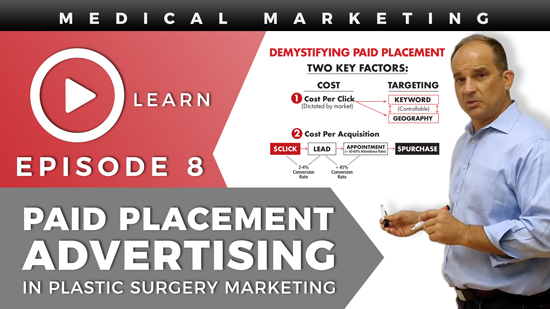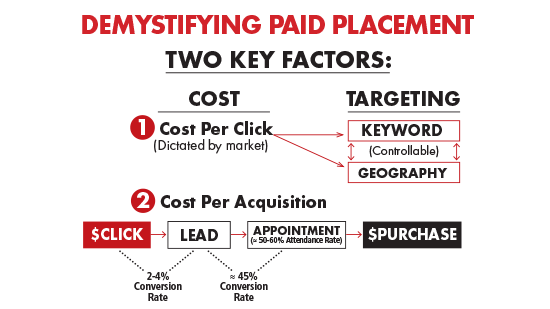What is Paid Placement Advertising for Plastic Surgery Practices?
Paid placement advertising is a marketing method by which a plastic surgery practice’s business listing is guaranteed to appear in the search engine results pages (SERPs) when specific keywords are searched for by a consumer.There are two major factors to consider in deciding whether or not to experiment with this advertising model. These factors determine whether the channel will be effective—or expensive and unprofitable—for a plastic surgery practice.
- Cost-Per-Click
- Cost-Per-Acquisition
Cost-Per-Click
Cost-per-click is controllable and gives you the opportunity to choose the keywords that you want to obtain traffic from.
For example, a plastic surgeon in Addison, Texas, that wants to increase the amount of breast augmentation procedures the practice handles, can choose to run paid ads for the specific keyword “breast augmentation.” The doctor can also decide what specific area to target. In this instance, the doctor may choose Dallas, Texas as the geo-targeted area.
These are a couple of the perks of paid placement advertising—you get to decide what keyword you target and what area to target. The cost-per-click will vary based on the popularity of the keyword and the competition in the market you choose. It’s important to only spend what you can realistically afford to spend because you may not see a positive return-on-investment and allocating too much of your marketing budget to a competitive outlet such as paid advertising can take away from other more effective and less expensive channels.
Advertisers don’t get the same opportunity with organic search. The prominence of your plastic surgery practice listing is dictated by your local address. Therefore, paid placement allows plastic surgeons to experiment outside of their traditional market. If your website doesn’t rank high for certain keywords (procedures or services), then you can supplement that with keyword advertising. This marketing mode allows you to augment your placement and play a defensive position against your competitors.
Cost-Per-Acquisition
Another important factor to consider in paid placement is your plastic surgery practice’s cost-per-acquisition. This metric will give you a better understanding of whether or not this marketing channel could potentially work with your particular budget and the procedures that you want to target.
In order to make a profit, you will most likely need to target high revenue procedures (i.e. breast augmentation). With paid placement advertising, you are paying for clicks. So each time a consumer clicks on an advertisement, it will cost you money.
Just because a consumer clicks on an ad, it does not guarantee they will become an actual lead. In a successful campaign, your click-to lead rate is going to be somewhere between 2-4% (on average), meaning for every 100 clicks your ad receives, only 2-4 of them will convert into leads and give you their personal information. See chart below for more paid placement advertising conversion metrics.
Due to the competitive nature of paid placement, you have to measure your KPIs and know your conversion metrics in order to calculate whether or not a campaign is successful. Cost-per-acquisition is one of the most important metrics for this media channel. If it costs more to acquire the new patient than they will be paying for the procedure you are promoting, then you will not see a positive return-on-investment and should consider another marketing method.
*A lead is an interested consumer that gives you a first name, last name, phone number, email address, and procedure of interest.

















